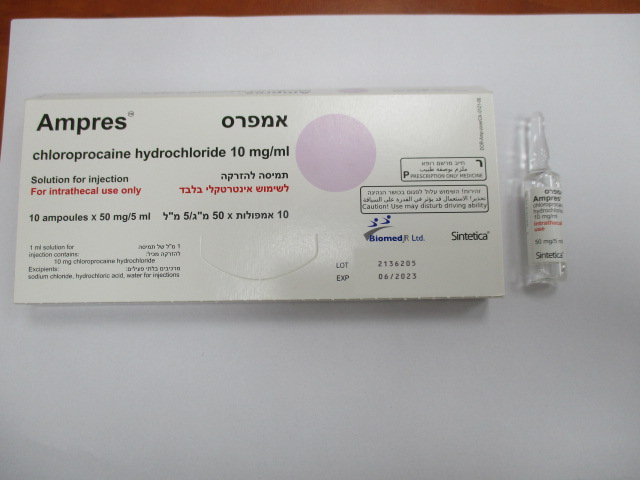Quest for the right Drug

אמפרס AMPRES (CHLOROPROCAINE HYDROCHLORIDE)
תרופה במרשם
תרופה בסל
נרקוטיקה
ציטוטוקסיקה
צורת מתן:
תוך-שדרתי : INTRATHECAL
צורת מינון:
תמיסה להזרקה : SOLUTION FOR INJECTION
עלון לרופא
מינוניםPosology התוויות
Indications תופעות לוואי
Adverse reactions התוויות נגד
Contraindications אינטראקציות
Interactions מינון יתר
Overdose הריון/הנקה
Pregnancy & Lactation אוכלוסיות מיוחדות
Special populations תכונות פרמקולוגיות
Pharmacological properties מידע רוקחי
Pharmaceutical particulars אזהרת שימוש
Special Warning עלון לרופא
Physicians Leaflet
Pharmacological properties : תכונות פרמקולוגיות
Pharmacodynamic Properties
5.1 Pharmacodynamic properties Pharmacotherapeutic group: anaesthetics, local; esters of aminobenzoic acid ATC code: N01BA04 Chloroprocaine, is an ester-type local anaesthetic. Chloroprocaine, blocks the generation and the conduction of nerve impulses, presumably by increasing the threshold for electrical excitation in the nerve, by slowing the propagation of the nerve impulse and by reducing the rate of rise of the action potential. The onset of action for spinal administration is very rapid (9.6 min ± 7.3 min at 40 mg dose; 7.9 min ± 6.0 min at 50 mg dose) and the duration of anaesthesia may be up to 100 minutes.
Pharmacokinetic Properties
5.2 Pharmacokinetic properties Absorption and Distribution The plasma concentration should be negligible for intrathecal use. Biotransformation Chloroprocaine is rapidly metabolized in plasma by hydrolysis of the ester linkage by pseudocholinesterase. This process could be decelerated in case of pseudocholinesterase deficiency. The hydrolysis of chloroprocaine results in the production of ßdiethylaminoethanol and 2-chloro-4- aminobenzoic acid. The in vitro plasma half-life of chloroprocaine in adults is 21 ± 2 seconds for males and 25 ± 1 seconds for females. The in vitro plasma half-life in neonates is 43 ± 2 seconds. In women, plasma half-lives in vivo of 3.1 ±1.6 minutes was measured. Elimination The metabolites, ßdiethylaminoethanol and 2-chloro-4-aminobenzoic acid, are excreted by the kidney into the urine. Pharmacokinetic in spine Elimination of chloroprocaine from the CSF is entirely by diffusion and vascular absorption, either in neural tissues in the intrathecal space or by crossing the dura along the concentration gradient between CSF and the epidural space. Consequently, chloroprocaine is subject to vascular absorption. The predominant factors determining the rate of absorption are local blood flow and competing binding to local tissues, but not enzymatic hydrolysis in the CSF. In patients with cholinesterase deficiency it is reasonable to expect very low peak plasma levels of chloroprocaine after intrathecal injection. Clearance of chloroprocaine from CSF by diffusion across the dura into the epidural space and subsequent systemic absorption may not be impaired to a clinically significant degree.

שימוש לפי פנקס קופ''ח כללית 1994
לא צוין
תאריך הכללה מקורי בסל
לא צוין
הגבלות
לא צוין
מידע נוסף
